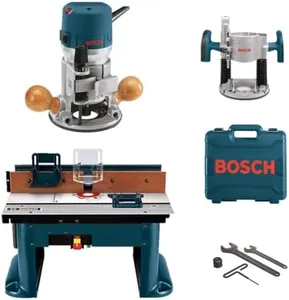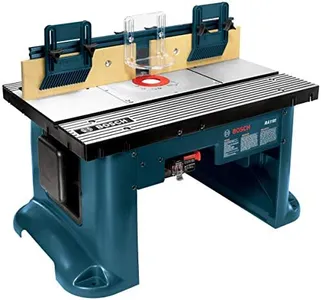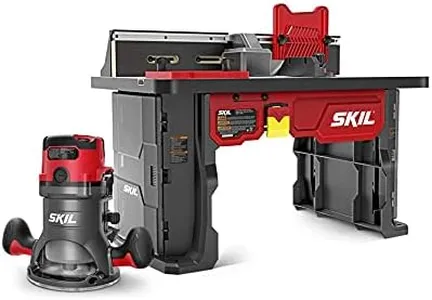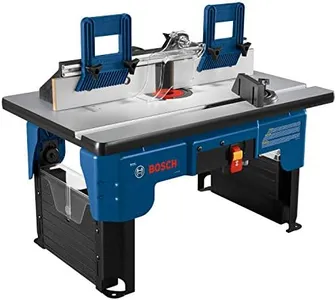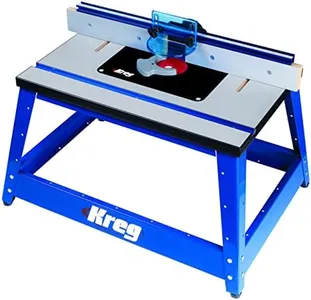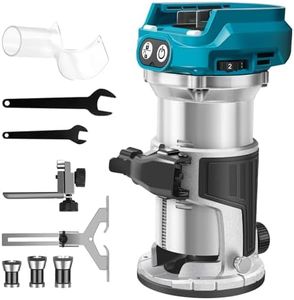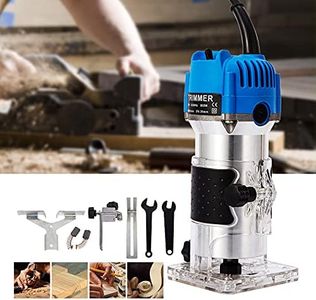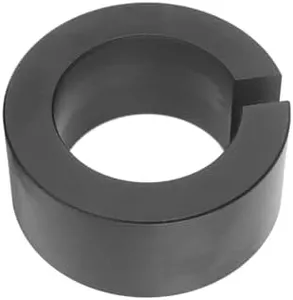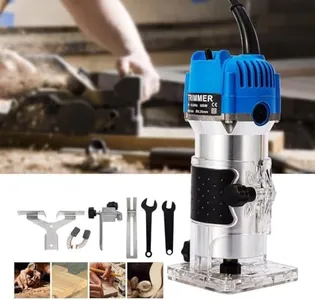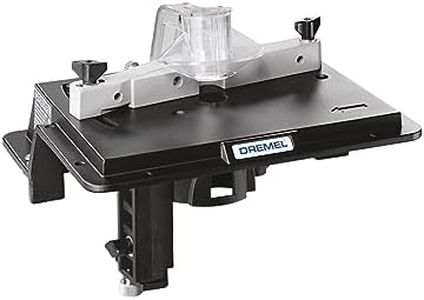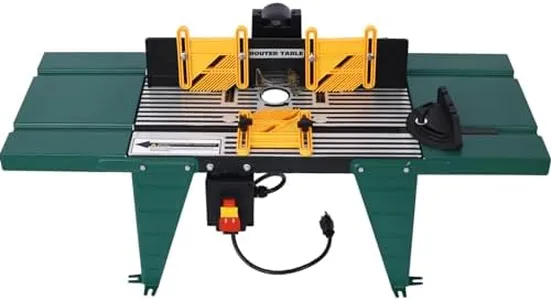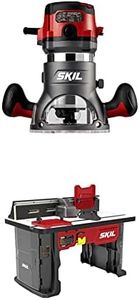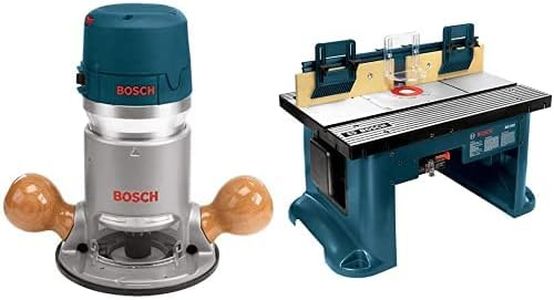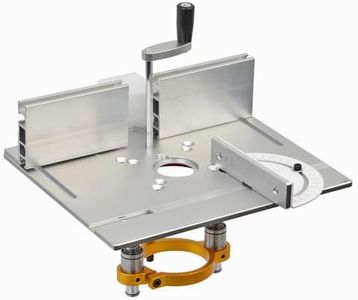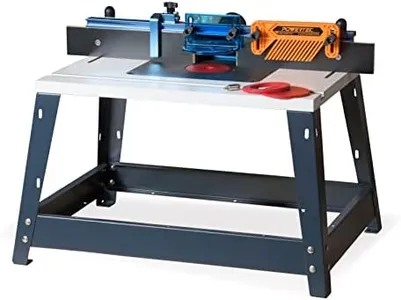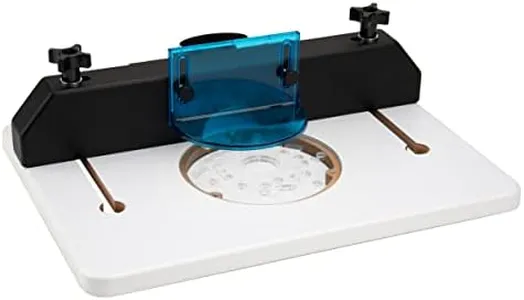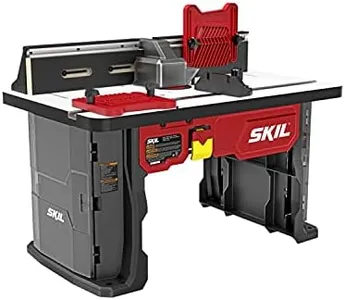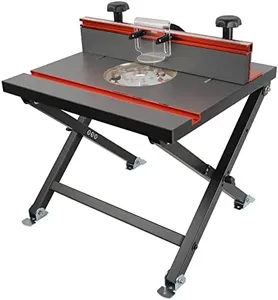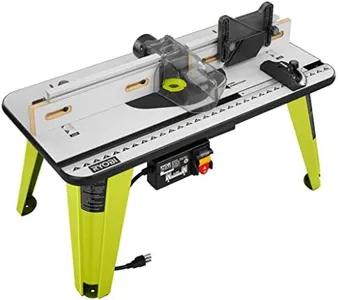10 Best Router Tables 2025 in the United States
Our technology thoroughly searches through the online shopping world, reviewing hundreds of sites. We then process and analyze this information, updating in real-time to bring you the latest top-rated products. This way, you always get the best and most current options available.

Our Top Picks
Winner
BOSCH 1617EVSPK Wood Router Tool Combo Kit - 2.25 Horsepower Plunge Router & Fixed Base Router Kit with a Variable Speed 12 Amp Motor and RA1181 Benchtop Router Table
Most important from
102 reviews
The Bosch 1617EVSPK Wood Router Tool Combo Kit, paired with the RA1181 Benchtop Router Table, offers a solid combination for woodworkers. The router includes a powerful 2.25 horsepower motor with variable speeds ranging from 8,000 to 25,000 RPM, which allows for fine control over a variety of woodworking tasks. The variable speed and soft start features add to the ease of use and precision of this tool.
The aluminum fence with MDF face plates and the aluminum router mounting plate provide durability and stability during use. The table size is suitable for most woodworking projects, and the benchtop design makes it relatively portable. The inclusion of adjustable featherboards and a dust collection port improves safety and cleanliness in your workspace.
Some users might find the 6-foot power cord limiting depending on their workshop setup. Additionally, while the router is versatile with both plunge and fixed base options, beginners may find the initial setup a bit complex. The kit's durability, power, and comprehensive features make it an excellent choice for both hobbyists and more experienced woodworkers.
Most important from
102 reviews
BOSCH RA1181 Benchtop Router Table 27 in. x 18 in. Aluminum Top with 2-1/2 in. Vacuum Hose Port
Most important from
4851 reviews
The BOSCH RA1181 Benchtop Router Table is designed to offer both durability and precision, making it a solid choice for woodworking enthusiasts. Its large 27 x 18-inch aluminum table provides ample workspace and ensures stability during use. The rigid aluminum mounting plate is pre-drilled, allowing for easy compatibility with various routers and facilitating above-table height adjustments.
The extra tall aluminum fence with adjustable faceplates and feather boards enhances precision and versatility, which is great for detailed projects. Additionally, the table includes a dedicated dust-collection port that fits standard 2-1/2 inch vacuum hoses, helping to maintain a clean workspace by efficiently collecting debris. Other practical features include adjustable feather boards for added guidance and protection, an accessory slot for miter gauges and other accessories, and storage options for router accessories and the power cord.
The router table is corded electric, ensuring consistent power supply, and its weight of 30 pounds might limit portability for some users. Furthermore, while the product offers a 1-year limited warranty and a 30-day money-back guarantee, users should be aware that it’s been on the market since 2004 and may not include the latest advancements found in newer models. In summary, the BOSCH RA1181 excels in providing a durable, precise, and user-friendly router table setup, though its heavier weight and age may be considerations for some potential buyers.
Most important from
4851 reviews
SKIL RT1323-01 Router Table and 10Amp Fixed Base Router Kit
Most important from
1180 reviews
The SKIL RT1323-01 Router Table and 10Amp Fixed Base Router Kit is a solid choice for hobbyists and DIY enthusiasts looking to delve into woodworking. One of its standout features is the powerful 10 Amp motor that provides a smooth routing experience. The router table includes thoughtful design elements like above-the-table adjustment, integrated bit storage, and a tall aluminum fence, which makes it easy to handle a variety of woodworking tasks with precision.
The adjustable fence and two featherboards are a great addition for users aiming for accurate cuts, especially with taller stock. The provided dust extraction adapter helps keep the workspace clean, which is a plus for those who value cleanliness while working. The combination of the router and table allows for versatility, enabling users to tackle both heavy routing and fine finishing tasks effectively.
There are a few drawbacks to consider. The setup can be a bit cumbersome for beginners, as getting everything aligned and adjusted correctly may take some time. While the table is portable, it weighs over 40 pounds, which may make it less convenient for those needing to move it frequently. Some users may find the size and weight a bit restrictive if they have limited workspace.
Most important from
1180 reviews
Buying Guide for the Best Router Tables
Choosing the right router table can significantly enhance your woodworking projects by providing stability, precision, and versatility. When selecting a router table, it's important to consider several key specifications to ensure it meets your needs and preferences. Understanding these specifications will help you make an informed decision and find the best fit for your woodworking tasks.FAQ
Most Popular Categories Right Now
